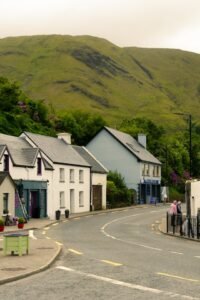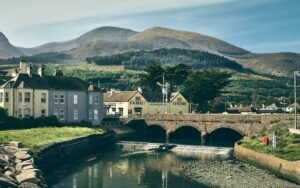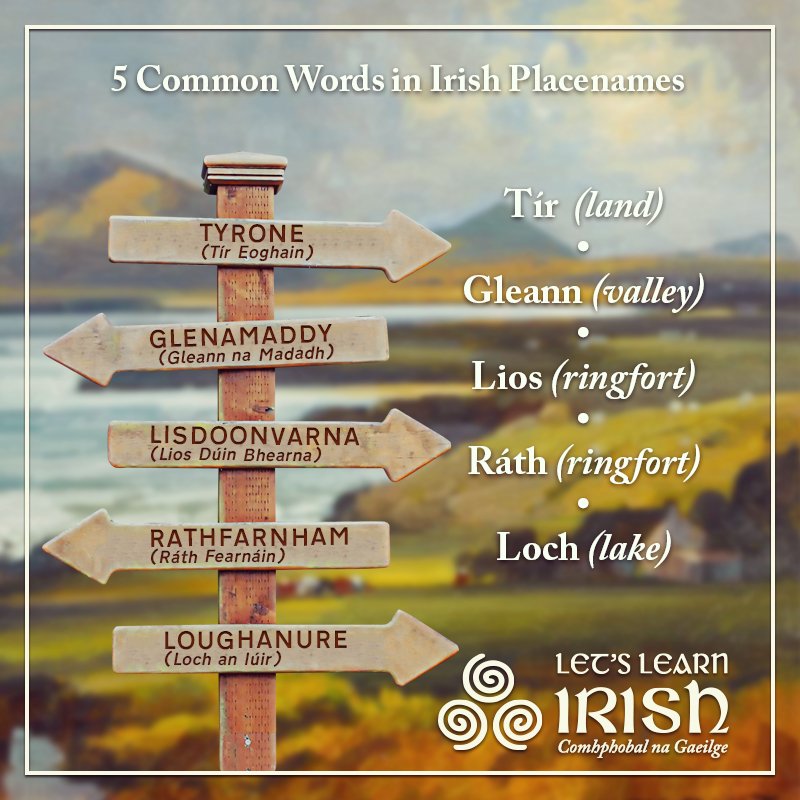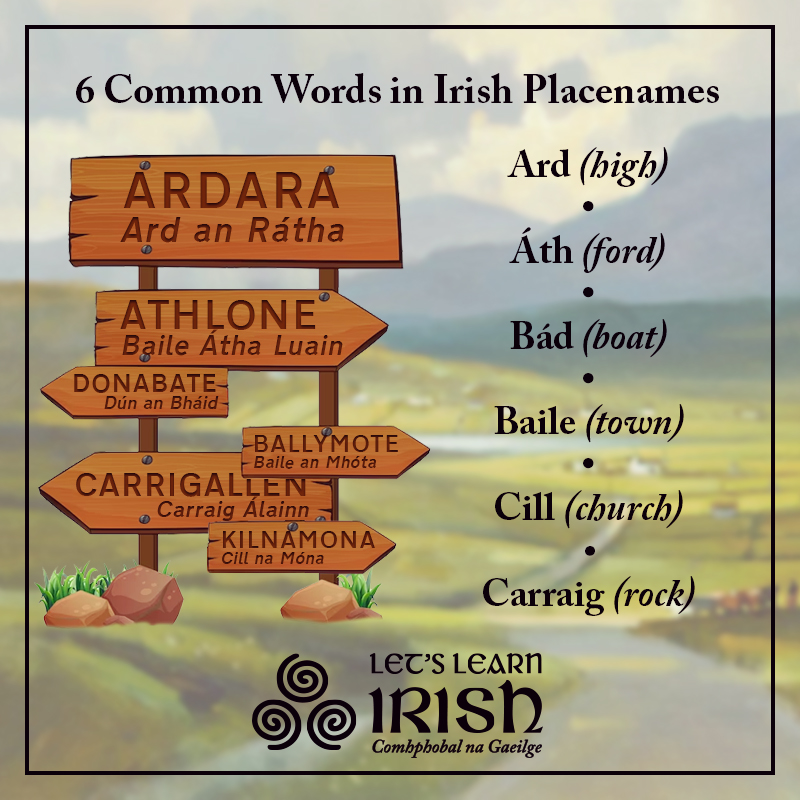Where do Irish Placenames Come From?
Logainmneacha / Placenames

You may not be surprised to read this, but some 90% of placenames in Ireland stem from the original Irish name!
So how did we actually end up with the system of anglicised names for villages and towns that we have now?
And for that matter, what do these words in our placenames, such as Dún, Cill, Loch, Rath, Ard, Bally, Lios and Gleann, actually mean??
In the Beginning...
 Irish placenames were first recorded in November 1824, with the beginning of the British Ordnance Survey. Efforts were made to decide a suitable English language spelling for each name which had not already an accepted standardised English orthographic form.
Irish placenames were first recorded in November 1824, with the beginning of the British Ordnance Survey. Efforts were made to decide a suitable English language spelling for each name which had not already an accepted standardised English orthographic form.
Those who recorded the placenames tended not to be literate in Irish, and this problem tended to be tackled in one of three ways. In some instances, they ignored the original Irish placename, and instead gifted the land a new name. This was particularly common for plantations, such as Uibh Failghe, which is now County Offaly, but was once called ‘King’s County’. On other occasions, the surveyors translated the name in an effort to preserve its meaning, so Caisleán an Ridire in Wicklow, for example, became ‘Knight’s Castle’. Alternatively, attempts were made to transcribe the name, despite lacking any knowledge of the Irish phonetic alphabet, such as An Aill, meaning ‘The Cliff’, in north Co. Dublin, became ‘Naul’. Numerous examples can be found of these anglicisations. Since the vast majority of the names originated in the Irish language, the standardised forms were to be anglicisations, such as ‘Baile’ becoming ‘Bally’ and ‘Cill’ becoming ‘Kil’, etc.
 The early surveyors of Ireland may have distorted our local placenames, but they nonetheless capture much local and family history. By using more than 2,700 tracings, these surveyors were able to confirm precise locations of townland boundaries, as established 168 years previously. This work ensured a reliable continuity in ancient boundaries of townlands, villages, civil parishes and baronies from the 1600s to the 21st century. Speaking of which, it may be useful to clarify some of the terminology used when describing land boundaries in Ireland, such as townland, parish, village, town and barony.
The early surveyors of Ireland may have distorted our local placenames, but they nonetheless capture much local and family history. By using more than 2,700 tracings, these surveyors were able to confirm precise locations of townland boundaries, as established 168 years previously. This work ensured a reliable continuity in ancient boundaries of townlands, villages, civil parishes and baronies from the 1600s to the 21st century. Speaking of which, it may be useful to clarify some of the terminology used when describing land boundaries in Ireland, such as townland, parish, village, town and barony.
The Terminology We Use
A townland, by the way, is an Irish geographical unit of land, smaller than a parish. Townlands were adopted in Norman times for administration, and were usually based on earlier Gaelic kingdom subdivisions.
A parish, on the other hand, is usually a cluster of townlands (there is an estimated total of 2500 parishes in Ireland).
A village typically consists of one main street, and a surrounding population of 1,000 to 2,500.
 A town, however, will usually have fixed boundaries, local government, residential districts, shops and amenities. Of course, the 305 towns of Ireland make up the 32 counties that we have today!
A town, however, will usually have fixed boundaries, local government, residential districts, shops and amenities. Of course, the 305 towns of Ireland make up the 32 counties that we have today!
Interestingly, during the Tudor reconquest of Ireland in the 1500s, counties were subdivide into ‘baronies‘. There are 331 baronies in Ireland, but nowadays they are rarely used for administrative purposes, and have only marginal relevance.
The Placenames Commission
 The rise of Nationalism in the 1900’s led to renewed interest in the Irish language. Both the 1922 Constitution of the Irish Free State (Saorstát Éireann) and Bunreacht na hÉireann, adopted in 1937, recognised Irish as the national language.
The rise of Nationalism in the 1900’s led to renewed interest in the Irish language. Both the 1922 Constitution of the Irish Free State (Saorstát Éireann) and Bunreacht na hÉireann, adopted in 1937, recognised Irish as the national language.
An Coimisiún Logainmneacha (The Placenames Commission) was thus established in 1946 to advise Ordnance Survey Ireland on Irish names for places throughout Ireland. Subsequently, the Place-Names (Irish Forms) Act 1973 codified into law the official assignment of Irish names alongside English names. Contemporary efforts to reinstate original placenames in Ireland duly raise complex, post-colonial questions, and entails negotiating concepts of cultural identity and location, authenticity, tradition and cultural retrieval.
Cheat Sheet for Placenames
As you can imagine, the process of anglicising Irish placenames followed a familiar pattern. See below for a ‘cheat sheet’ that you can reference as you explore this topic in more detail…
FROM IRISH WORD…
Baile
Bán
Carn
Carraig
Droim
Dubh
Gleann
Cill
Loch
Mullach
Ráth
Sliabh
Tír
FROM IRISH WORD…
Baile
Bán
Carn
Carraig
Droim
Dubh
Gleann
Cill
Loch
Mullach
Ráth
Sliabh
Tír
= MEANING
Town
White
Mound
Rock
Ridge
Black
Glen
Church
Lake
Hilltop
Fort
Mountain
Country
Further Reading
Fortunately, if you want to find out more about placenames, there is a wonderful database of 7,000 places listed at logainm.ie ((Bunachar Logainmneacha na hÉireann/The Placenames Database of Ireland). This is an excellent resource for historians, genealogists and language learners alike.
You might also like to check out the following articles on placenames:
 Where can you find places with that mention Ard, Áth, Bád, Baile, Cill and Carraig?
Where can you find places with that mention Ard, Áth, Bád, Baile, Cill and Carraig?
What’s the meaning of areas featuring Cluain, Cnoc, Coill, Droim and Dún in their titles?
Have you heard of anywhere with words such as Tír, Gleann, Lios, Ráth and Loch?
For further study, you might also like to look at this publication, The Origin and History of Irish Names of Places (1887).
Join the online Irish community for cúrsaí, comhrá & ceardlanna, and follow along on social media @LetsLearnIrish – beidh fáilte romhat!





